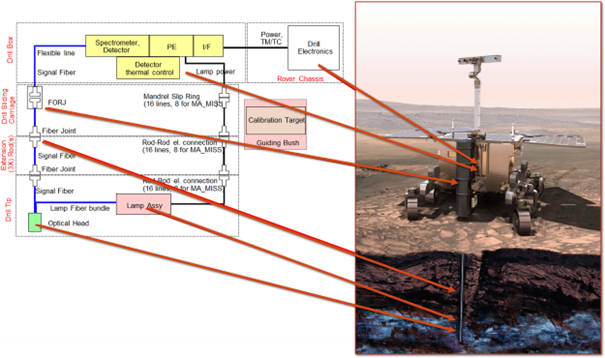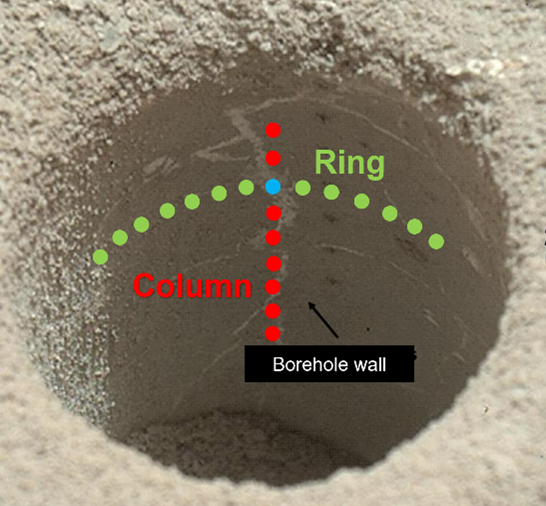Ma_MISS: a powerful tool for exploring the Martian subsurface
- 1Istituto di Astrofisica e Planetologia Spaziali-INAF, Roma, Italy
- 2Agemzia Spaziale Italiana, Rome, Italy
Introduction: Mars is a primary destination to search for signs of life and probing the subsurface is a key element in this search. Access to the Martian subsurface, under most altered layers, is needed to understand the nature, timing and duration of alteration and sedimentation processes on Mars, as well as habitability conditions. For such a reason, ExoMars rover mission includes a drill to collect subsurface samples and has a complex payload able to conduct detailed investigations of composition, search for organics, and recognize indicators of past or extant life[1]. The drill is a critical element of the mission which will explore and collect samples down to 2 m of depth. An essential part of the payload is Ma_MISS (Mars Multispectral Imager for Subsurface Studies) experiment hosted by the drill system[2,3]. Ma_MISS is a Visible and Near Infrared miniaturized spectrometer with an optical head inside the drill tip capable of observing the borehole from where samples are collected.
Ma_MISS instrument description: Ma_MISS miniaturized spectrometer is hosted inside the drill system of the ExoMars rover and will characterize the mineralogy and stratigraphy of the excavated borehole wall at different depths (up to 2 m).
|
Ma_MISS is a modular instrument, and it consists of two main parts: (i) the spectrometer with the PE located outside of the drilling tool, and (ii) the Optical Head (OH) and fibers located inside the drill itself (Fig.1). The Drill consists of a main rod and three additional rods to reach a maximum depth of 2 m. The drill tip also has the Ma_MISS OH with a sapphire window to observe the borehole wall. All the rods are equipped with optical fibers to transmit light and signal. Ma_MISS is equipped with a light source of 5W and the illumination spot is about 1 mm at a focal distance of about 0.6 mm. The reflected light is collected through a 120 μm spot. The spectrometer observes a single point on the borehole wall and, using the drill movements, can build up images of the target. By combining several column and ring observations, Ma_MISS allows the reconstruction of a complete image of the borehole wall (Fig.2). Ma_MISS spectral characteristics and fine spatial resolution enable the in situ investigation of rocks, prior the sample collection, that will be manipulated and crushed for further analysis by the analytical laboratory. Thus, Ma_MISS is the instrument that will closely investigate the mineralogical characteristics of Mars subsurface material in its original geologic context.
|
What mineralogy is expected in the subsurface ? Ma_MISS will investigate deeper into the subsurface than prior rover missions. Viking and Phoenix landers scooped materials from the upper few centimeters for compositional analysis. The MER excavated trenches up to 11 cm deep[4] and collected data with the alpha-particle x-ray spectrometer and Mossbauer instruments. The MERs [5] grounded up to 9 mm deep and revealed coatings enriched in S, Cl, Zn and Ni and iron oxides on outer rock surfaces. The MER data from the subsurface show that those soils had high ferric sulfate contents or silica contents, likely signaling an influence from volcanic or hydrothermal processes[6,7]. Mars Science Laboratory (MSL) drilled several holes into the Martian surface demostraing differences between the surface and the subsurface, as shown in the colors of the excavated fines, mainly linked with the oxidation state of the materials[8]. Most interesting is the fact that well preserved organic material was discovered at Pahrump Hills , even with the very harsh surface conditions, suggesting even better preservation may be possible farther beneath the Martian surface[9].
Differently from the previous missions, the drill and Ma_MISS measurements will be the deepest compositional measurements made on Mars. Ma_MISS is able to detect compositional gradients with depth, changes in type and abundance of minerals, weathering fronts or rinds, and diagenetic veins or nodules. The spectral range of Ma_MISS is optimal to detect changes in the occurrence and crystal chemistry of olivines and pyroxenes as well as Fe(II)/Fe(III) in silicates, oxides, and salts. There may be changes in these redox sensitive minerals with depth that record different environments. Furthermore, changes in the hydration state of materials can be also detected. For Oxia, the study of the subsurface could provide information on depositional regimes in zones not too far from the delta deposits, using the granulometric variation with dept.This will help to reconstruct the paleoenvironments that have characterized Oxia Planum.
In addition, at sufficient concentrations, organic molecules will also be detectable [10]: depending on the kind of organic, Ma_MISSis capable to detect their presence even when a 1 wt.% in the mixture, as verified by specific tests in the laboratory using the Ma_MISS breadboard. Spectroscopic measurements on these mineral/organic mixtures are useful to understand how the Ma_MISS instrument can detect traces of organic intimately mixed with minerals.
Conclusion: Ma_MISS will reconstruct the 3-D images of the borehole excavated by the ExoMars drill and will acquire spectra of the subsurface layers from which the sample will be collected. The calibration and tests performed with the flight model demonstrate the ability of the instrument in detecting most of the spectral signatures expected in Martian subsurface, including those due to the presence of possible salts and organics.
Acknowledgments. This work is fully funded and supported by the Italian Space Agency (ASI) [Grant ASI-INAF n. 2017-48-H.0].
References. [1] Vago et al. (2017) Astrobiology 17, 471–510. [2] De Sanctis, M. C. et al. (2017) Astrobiology, 17(6–7). [3] De Sanctis et al. (2022) PSJ in press. [4] Sullivan, R., et al.. (2011), J. Geophys. Res., 116, E02006; [5] Gorevan et al., (2003), J. Geophys. Res., 108, 8068; [6] Gellert, R and Yen, A.S, (2019) Remote Compositional Analysis, 10.1017/9781316888872, (555-572); [7] Morris et al., (2019), Remote Compositional Analysis, 10.1017/9781316888872, (538-554); [8] Abbey et al., (2020), Icarus, /doi.org/10.1016/j.icarus.2020.113885. [9] Eigenbrode et al., 2018, Science, doi/10.1126/science.aas9185, [10] Ferrari et al., 2022. In preparation.
How to cite: De Sanctis, M. C., Altieri, F., De Angelis, S., Ferrari, M., Frigeri, A., Fonte, S., Ammannito, E., Brossier, J., Giardino, M., Apuzzo, A., costa, N., and rossi, L.: Ma_MISS: a powerful tool for exploring the Martian subsurface, Europlanet Science Congress 2022, Granada, Spain, 18–23 Sep 2022, EPSC2022-104, https://doi.org/10.5194/epsc2022-104, 2022.



